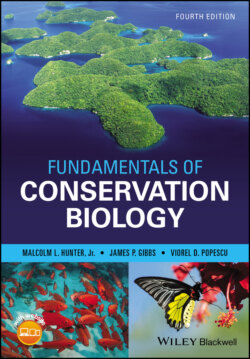Читать книгу Fundamentals of Conservation Biology - Malcolm L. Hunter Jr. - Страница 62
Spiritual Values
ОглавлениеWho does not delight in the beauty of a calypso orchid? We are all inspired by the majesty of a golden eagle. We find spiritual comfort in the transformation of a caterpillar into a monarch butterfly. The sight of baby animals usually activates our own nurturing instincts. In other words, people love living things, a phenomenon called “biophilia” by E. O. Wilson (1984).
It is easy to find evidence of our aesthetic, spiritual, and emotional affinity for other species. This linkage is revealed in the symbols we choose for our governments, religions, businesses, and athletic teams; think of the sugar maple leaf emblem of Canada, the wild animal totems of Native American tribes, the Jaguar sports car, the banana slug mascot of the University of California at Santa Cruz. Indeed, most nations (142 of 196 by one count) have selected animal species as their national symbol, although this does not always translate into successful conservation (Hammerschlag and Gallagher 2017). We also show our affinity for certain species in the motifs we use to decorate our clothing, jewelry, and dwellings, and in the places we select to visit in our leisure time. Our language – busy as a bee, an eager beaver, happy as a clam – reveals the depth of this linkage (Sommer and Sommer 2011).
Sometimes, our feelings for other species are revealed in the ways we spend our money; sometimes, they are not. Imagine a woman who lives her whole life in landlocked Kazakhstan who will never see a living blue whale, but who derives pleasure from simply knowing that blue whales exist. Her love for whales is real and valuable, but costs her nothing. It is hard for society to account for feelings like hers when making policy decisions because economic issues are usually paramount, and her feelings are not easily expressed in monetary units. But this does not make her feelings unimportant. It also does not diminish the political impact of her feelings. For example, the decision to curtail exploiting Newfoundland’s baby harp seals for their fur was made not because it was unsustainable (harp seals are doing well) but because of the deep feelings of people who had no direct contact with harp seals and no economic stake in their fate. Economists are trying to devise methods for estimating the monetary value of blue whales and harp seals for people whose only relationship with them is knowing that they exist; we will discuss existence values further in Chapter 16, “Economics.”
